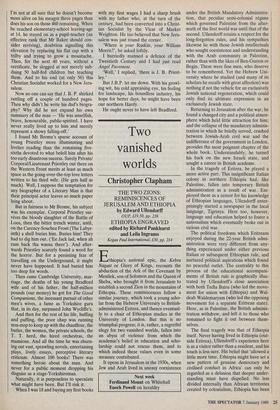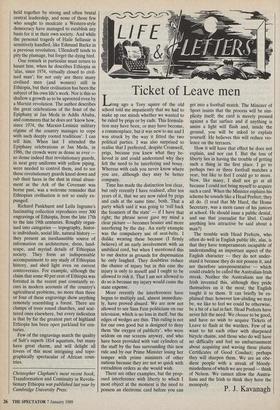Two vanished worlds
Christopher Clapham
THE TWO ZIONS: REMINISCENCES OF JERUSALEM AND ETHIOPIA by Edward Ullendorff
OUP, L19.50, pp. 238
ETHIOPIA ENGRAVED edited by Richard Pankhurst and Leila Ingrams
Kegan Paul International, £30, pp. 214
Ethiopia's national epic, the Kebra Nagast or Glory of Kings, recounts the abduction of the Ark of the Covenant by Menilek, son of Solomon and the Queen of Sheba, who brought it from Jerusalem to establish a second Zion in the mountains of Ethiopia. These reminiscences follow a similar journey, which took a young scho- lar from the Hebrew University to British- administered Eritrea, and thence eventual- ly to a chair of Ethiopian studies in the University of London. But this is no triumphal progress; it is, rather, a regretful elegy for two vanished worlds, fallen into an abyss of violence from which the academic's belief in education and scho- larship could not rescue them, and to which indeed these values even in some measure contributed.
It opens in Jerusalem in the 1930s, when Jew and Arab lived in uneasy coexistence under the British Mandatory Administra- tion, that peculiar semi-colonial regime which governed Palestine from the after- math of the first world war until that of the second. Ullendorff retains a respect for the long-forgotten rules, and his sympathies likewise lie with those Jewish intellectuals who sought coexistence and understanding with the Arab community in Palestine, rather than with the likes of Ben-Gurion or Begin. These were fine men, who deserve to be remembered. Yet the Hebrew Uni- versity where he studied (and many of its scholars he recalls with great affection) was nothing if not the vehicle for an exclusively Jewish national regeneration, which could only find its ultimate expression in an exclusively Jewish state.
Returning to Jerusalem after the war, he found a changed city and a political atmos- phere which held little attraction for him; and the collapse of the mandatory adminis- tration in which he briefly served, crushed between Jewish-Arab civil war and the indifference of the government in London, provides the most poignant chapter of the whole book. Understandably, he turned his back on the new Israeli state, and sought a career in British academe.
In the tragedy of Eritrea, he played a more active part. This insignificant Italian colony in northern Ethiopia had, like Palestine, fallen into temporary British administration as a result of war. Em- ployed there as a censor for his knowledge of Ethiopian languages, Ullendorff enter- prisingly started a newspaper in the local language, Tigrinya. Here too, however, language and education helped to foster a nationalism which eventually broke out in vicious civil war.
The political freedoms which Eritreans enjoyed during the 22-year British admi- nistration were very different from any- thing experienced under either previous Italian or subsequent Ethiopian rule, and nurtured political aspirations which found no peaceful outlet. The centrality to this process of the educational accompani- ments of British rule is graphically illus- trated by Ullendorff's close association with both Tedla Bairn (who led the move- ment for union with Ethiopia) and Wal- deab Waldemaryam (who led the opposing movement for a separate Eritrean state). Here, as in Palestine, the British adminis- tration withdrew, and left it to those who remained to fight it out between them- selves.
The final tragedy was that of Ethiopia itself. Never having lived in Ethiopia (out- side Eritrea), Ullendorff's experience here is as a visitor rather than a resident, and his touch is less sure. His belief that 'allowed a little more time, Ethiopia might have set a new pattern of genuine democracy and civilised conduct in Africa' can only be regarded as a delusion that deeper under- standing must have dispelled. No less divided internally than African territories created by colonialism, Ethiopia has been held together by strong and often brutal central leadership, and none of those few who sought to inculcate a Western-style democracy have managed to establish any basis for it in their own society. And while the personal tragedy of Haile Sellassie is sensitively handled, like Edmund Burke in a previous revolution, Ullendorff tends to pity the plumage, but forget the dying bird.
One remark in particular must return to haunt him, when he describes Ethiopia as `alas, since 1974, virtually closed to civil- ised man'; for not only are there many civilised men (and women) still in Ethiopia, but their civilisation has been the subject of his own life's work. Nor is this so shallow a growth as to be uprooted even by a Marxist revolution. The author describes the great celebrations of the feast of the Epiphany at Jan Meda in Addis Ababa, and comments that he does not 'know how, since 1974, the Marxist-Leninist military regime of the country manages to cope with such deeply rooted traditions'. I can tell him. When last I attended the Epiphany celebrations at Jan Meda, in 1986, the crowds were as dense as ever so dense indeed that revolutionary guards, in neat grey uniforms with yellow piping, were needed to control them, and to see these revolutionary guards kneel down and rub their faces in the dust in ritual abase- ment as the Ark of the Covenant was borne past, was a welcome reminder that Ethiopian civilisation is not so easily ex- punged.
Richard Pankhurst and Leila Ingrams's fascinating collection reproduces over 300 engravings of Ethiopia, from the late 17th to the late 19th centuries. Roughly organ- ised into categories — topography, histor- ic individuals, social life, natural history they present an inexhaustible source of information on architecture, dress, land- scape, and myriad details of Ethiopian society. They form an indispensable accompaniment to any study of Ethiopian history, and shed light even on current controversies. For example, although the claim that some 40 per cent of Ethiopia was forested in the recent past constantly re- curs in modern accounts of the country's agricultural problems, no more than three or four of these engravings show anything remotely resembling a forest. There are clumps of trees round churches, and scat- tered ones elsewhere, but every indication is that by far the greatest part of highland Ethiopia has been open parkland for cen- turies.
Few of the engravings match the quality of Salt's superb 1814 aquatints, but many have great charm, and will delight all lovers of this most intriguing and topo- graphically spectacular of African coun- tries.
Christopher Clapham's most recent book, Transformation and Continuity in Revolu- tionary Ethiopia was published last year by Cambridge University Press.











































 Previous page
Previous page